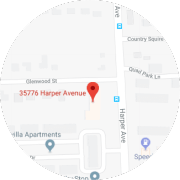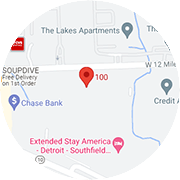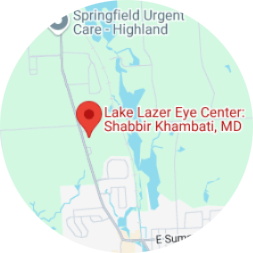What is Glaucoma?
 Glaucoma is a disease that affects the optic nerve, the part of the eye which receives images collected by the retina and sends them to the brain. Every eye maintains a certain amount of internal pressure, called intraocular pressure. When this pressure rises to abnormal levels, it can put extra stress on the optic nerve, causing significant damage. Optic nerve damage results in loss of vision and, ultimately, blindness.
Glaucoma is a disease that affects the optic nerve, the part of the eye which receives images collected by the retina and sends them to the brain. Every eye maintains a certain amount of internal pressure, called intraocular pressure. When this pressure rises to abnormal levels, it can put extra stress on the optic nerve, causing significant damage. Optic nerve damage results in loss of vision and, ultimately, blindness.
The front of the eye is constantly producing a fluid called aqueous humor. A healthy eye will continually produce small amounts of aqueous humor to ensure consistent pressure within the eye. When normal drainage becomes slowed or blocked, pressure increases and may lead to glaucoma. There are several different types of glaucoma. The two most common types are chronic open-angle glaucoma and closed-angle glaucoma.
Chronic Open-Angle Glaucoma
Chronic open-angle glaucoma is the most common form of the disease and usually develops with age. With this type of glaucoma, pressure gradually increases around the eye, causing it to work less effectively over a period of time. There are no symptoms in the early stages of open-angle glaucoma. Peripheral vision is usually the first to deteriorate. As the disease becomes more advanced, blank spots begin to appear in one’s vision. If left untreated, it eventually develops to blindness.
Risk factors for Chronic Open-Angle Glaucoma Include:
- Advanced age
- Family history of the disease
- Higher-than-normal intraocular pressure
- Certain ethnic races, particularly those of African descent
- Certain diseases or conditions, especially diabetes, farsightedness or nearsightedness, or previous eye trauma or surgery
Closed-Angle Glaucoma
Closed-angle glaucoma is less prevalent but is considered a real eye emergency. This type of glaucoma occurs when a patient’s pupil moves or dilates and actually blocks off the drainage angles in the eye. This is considered a medical emergency in which an ophthalmologist should be contacted immediately to avoid any loss of vision.
Symptoms of Closed-Angle Glaucoma Include:
- Severe eye pain
- Headache
- Blurred vision
- Nausea or vomiting
- Rainbow halos around lights
Risk Factors for Closed-Angle Glaucoma Include:
- Extreme farsightedness
- An iris that is abnormally large or far back in the eye
- Advanced age
- Heredity
- Certain ethnic races
Early Detection
Vision loss from glaucoma is permanent but can usually be prevented with early detection and treatment. Glaucoma management is usually a lifelong process that requires frequent monitoring and constant treatment. Since there is no way to determine if glaucoma is under control based on how a person feels, doctor visits should be on a regular basis.
Treatments for Glaucoma
There is a wide range of treatments for the disease, including medication, LASER surgery and traditional surgery. The treatment (or combination of treatments) for an individual is chosen based upon the type of glaucoma and other details of the particular case. One option is medication such as prescription eye drops which help to reduce intraocular pressure, or pills called carbonic anhydrase inhibitors which slow down fluid production within the eye.
LASER surgery has also become a common treatment option for glaucoma. For open-angle glaucoma, your doctor may choose a trabeculoplasty, a painless laser procedure, which uses light to shrink and stretch eye tissue to allow more drainage of fluid. For closed-angle cases, in which the iris is blocking drainage of aqueous humor, a LASER surgery called iridotomy may be performed.
Selective Laser Trabeculoplasty (SLT)
SLT (Selective Laser Trabeculoplasty) is a safe and simple in-office laser treatment that effectively reduces eye pressure for most patients with glaucoma. The SLT mechanism of effect does not rely on medicines, instead, it uses an advanced laser system to target only specific cells of the eye—those containing melanin, a natural pigment. This allows for only these cells to be affected, leaving surrounding tissue intact. As a result, your body’s own healing response helps lower the pressure in your eye.
Selective Laser Therapy (SLT) is an advancement over other lasers that have been used in the treatment of open-angle glaucoma for more than two decades.
Benefits of SLT:
- Safe: SLT is not associated with systemic side effects or the compliance and cost issues of medications.
- Selective: SLT utilizes selective photothermolysis to target only specific cells, leaving the surrounding tissue intact.
- Smart: SLT stimulates the body’s natural mechanisms to enhance outflow of the fluid in your eye.
- Sensible: SLT therapy is reimbursed by Medicare and many other insurance providers, which minimizes your out-of-pocket expenses.
Other glaucoma treatment options involve various traditional surgeries. A common surgery for open-angle glaucoma is the trabeculectomy, where a doctor creates a small flap in the sclera (white part of the eye). Underneath the surface of the sclera, the doctor creates a small reservoir, called a filtration bleb, into which aqueous fluid may drain and then be disbursed, further reducing intraocular pressure.
There are a number of treatments available for glaucoma patients. If diagnosed with glaucoma, your ophthalmologist will consult with you on your options in order to maintain the best possible health of your eyes.

 586-792-3891
586-792-3891




